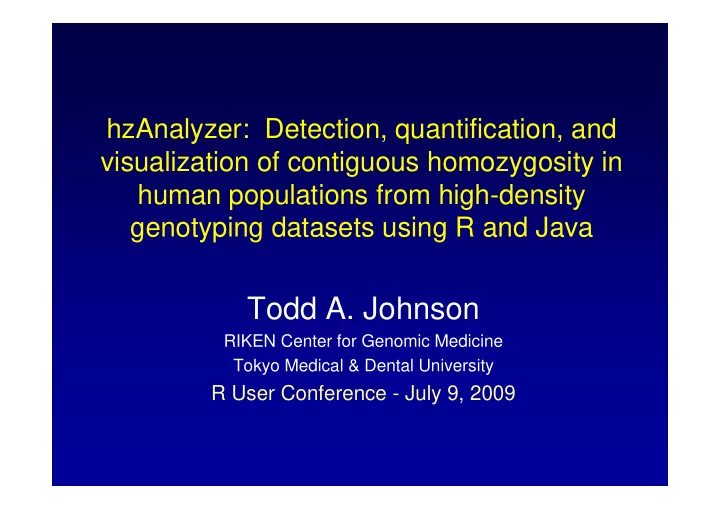

hzAnalyzer: Detection, quantification, and visualization of contiguous homozygosity in human populations from high-density genotyping datasets using R and Java Todd A. Johnson RIKEN Center for Genomic Medicine Tokyo Medical & Dental University R User Conference - July 9, 2009
Homozygosity? • Humans are diploid organisms, which means we each have two homologous chromosomes • For a polymorphic locus that is bi-allelic, two alleles labeled A and a can be: – homozygous AA or aa – Heterozygous Aa • We can recode: – AA and aa as 1 – Aa as 0 A contiguous homozygous segment then would be the red 1’s in the following: 01111111111010111011 Of course segments with 1, 2, or 3 homozygous loci is not so important, but other longer runs may be interesting…
International HapMap Project • \
Contiguous homozygous segments in two regions of HapMap sample data Position (Mb)
Detection of homozygous segments • hzAnalyzer incorporates a heuristic multi-step algorithm which was used to detect segments of contiguous homozygous loci within the 269 HapMap Phase 2 samples – 3,040,424 loci genome-wide SNPs – 2,956,629 autosomal loci • Data processing – Minor allele frequency >0.01 in at least one population – Removed loci that intersected with copy-number variable regions, Ig V H /V κ /V λ ,segment duplications
Detection algorithm snpMatrix • – Bioconductor package with excellent file input routines, compact binary data representation, and genotype/sample summary methods for storing and manipulating genotype data. • Homozygous detection is run in a Java process that instantiates classes for: – Sample organization • Samplegroup • Individual with mother/father relationship info when appropriate – Data representation • Genotypes • Haplotypes • Segments of zygosity – Data processing • Instantiation of group, individual, genotype objects • Segment detection function
Detection algorithm •Basic homozygous segment detection •Detect runs of homozygous loci allowing no-call genotypes but split at gaps>14kb Neighbor joining across regions of low SNP density •Join segments A & B if: • A & B and combined segment A+B > 0.2 SNP/kb •A & B have length greater than 0.1*gap_size Or if A>0.1*gap_size but not B then scan past B and see if the addition of subsequent segments passes length and SNP density thresholds Modeling segments with low levels of heterozygosity •Join segment HOM A , HET B , and HOM C if: •Freq HOMA+HETB <0.6% & Freq HETB+HOMC <0.6% •Or if only Freq HOMA+HETB <0.6% then scan past C and see if the addition of subsequent segments passes heterozygosity, length, and SNP density thresholds
Filtering terminology • Homozygosity probability score (HPS) – Simple procedure • Measure the proportion of observed homozygous loci within a population for each SNP – Freq HOMin = frequency of homozygous genotypes within population – Freq HOMex = lowest frequency of homozygous genotypes across examine populations – HPS in = Product of Freq HOMin for loci within a segment – HPS ex = Product of Freq HOMex for loci within a segment – Goal is that each segment has some relative likelihood of being really homozygous based on the number of loci that are examined and each loci’s heterozygosity.
Filtering terminology Chrom. MISL chr • Minimum inclusive segment length (MISL) 1 391,555 2 385,789 – Simple procedure 3 400,822 4 355,550 • Find the maximum length segment (Max L )in each 5 264,726 6 309,973 individual 7 308,518 • Find the minimum Max L across the individuals 8 315,796 9 228,061 – Depending upon sample populations or specific 10 229,520 analysis, can choose subsets of groups or 11 293,727 12 311,633 chromosomes 13 248,643 14 268,112 • MISL gw = genome-wide 15 242,482 • MISL chr = different value for each chromosome 16 239,646 17 270,268 • MISL chrn,n+1,… = between a group of 18 179,120 chromosomes 19 270,633 20 168,531 21 131,431 22 155,041 X 457,502
Total length of homozygous segments in HapMap populations Total length of homozygous segments (Total SNP count) Population HPS in <0.01 HPS ex <0.01 HPS ex <0.01, >=MISL gw YRI 0.67 x 10 9 (0.8 x10 6 ) 0.85 x 10 9 (1.0 x10 6 ) 0.15 x 10 9 (0.13 x10 6 ) CEU 0.98 x 10 9 (1.1 x10 6 ) 1.15 x 10 9 (1.31 x10 6 ) 0.40 x 10 9 (0.37 x10 6 ) CHB 1.06 x 10 9 (1.2 x10 6 ) 1.25 x 10 9 (1.42 x10 6 ) 0.50 x 10 9 (0.46 x10 6 ) JPT 1.07 x 10 9 (1.2 x10 6 ) 1.27 x 10 9 (1.43 x10 6 ) 0.52 x 10 9 (0.48 x10 6 )
Extended homozygosity on autosomes • YRI population shows much lower levels of contiguous homozygosity across all examined segment lengths as compared to the other three populations.
Distribution of homozygous segments on Chromosome X differs markedly from autosomes Median total length >=MISL chr7,8,X Chr.X median total length relative to: Population Chr. 7 Chr. 8 Chr. X Chr.7 Chr.8 YRI 2.4 x10 6 2.6 x10 6 5.7 x10 6 239% 220% CEU 7.5 x10 6 9.3 x10 6 21.5 x10 6 286% 230% CHB 10.1 x10 6 11.2 x10 6 31.0 x10 6 307% 277% JPT 10.7 x10 6 12.6 x10 6 34.4 x10 6 322% 273%
How do we make sense out of all of those overlapping segments? -> Develop a measure to quantify local variation of homozygous extent and relative population frequency.
Percentile-Extent matrix (PE mat ) derivation • Tabulate for each locus the length of intersecting homozygous segments SNPs Subject #1 Subject #2 Subject #... Subject #n For each SNP, determine the percentile distribution of the lengths of any intersecting segments
Recommend
More recommend